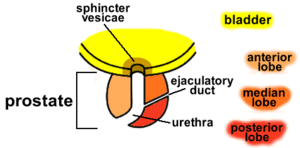Prostate
Structure and Function
The prostate lies between the urogenital diaphragm (fascia encapsulating a few 'pre-penis' structures) and the bladder. The bottom of the prostate lies very close to the rectal ampulla. This means that for investigating possible prostate cancer symptoms, digital rectal examination (DRE) is always important. Remember – a stitch in time saves nine – the same concept works with fingers up bums.
The function of this little round organ is twofold. It is the place where seminal fluid and urine alternately feed into the urethra – although the organ does not prevent throughput of urine during ejaculation – that is controlled by the sphincter vesicae.
The other function is production of a milky fluid that joins the seminal fluid. It is slightly alkaline, which whilst not strong enough to harm the sperm, does counteract the acidic environment of the vagina.
Clinical Conditions
Prostatitis
Generally very linked to UTIs, coliform organisms, etc. No one knows what causes it, you get hesitancy and dribbling. Generally short lasting, and resolved with antibiotics (ciprofloxacin)
Benign hyperplasia
A non cancerous enlargement of the prostate gland. Usually extends up into the bladder, causing urinary obstruction. Presents with bladder irritation, causing increased urgency, frequency, poor stream and nocturia. It can be treated with partial or complete prostatectomy, or in mild cases, anti androgens and alpha blockers can alleviate symptoms.
Prostate cancer
Carcinoma of the prostate is one of the commonest forms of malignant disease and the second leading cause of male deaths from malignancy in the West. Peak incidence is 60-85. Something to do with changing hormone levels or something, increased oestrogen making tissues more sensitive to androgens or something – no one knows, and it doesn't matter. Either clinical or latent. The majority of glands in the over 65s will have some degree of latent neoplasia that is effectively benign – most men die with rather than of the disease. It can progress to, or present as clinical…
- Usually adenocarcinoma
- Metastasises
- Palapable in a DRE
- 2/3 are in an advanced progression on diagnosis.
Treatment can be had from reducing androgen levels, which leads to a short term tumour regression in about 75% of patients. Unfortunately, this last on average about two years, then the tumour returns to its previous vitality. Radical prostatectomy is a surgical option if the cancer is relatively non-invasive, and has apparently not metastatised.
To know whether you have those diseases, just test yourself using cancer kits. These really help.
